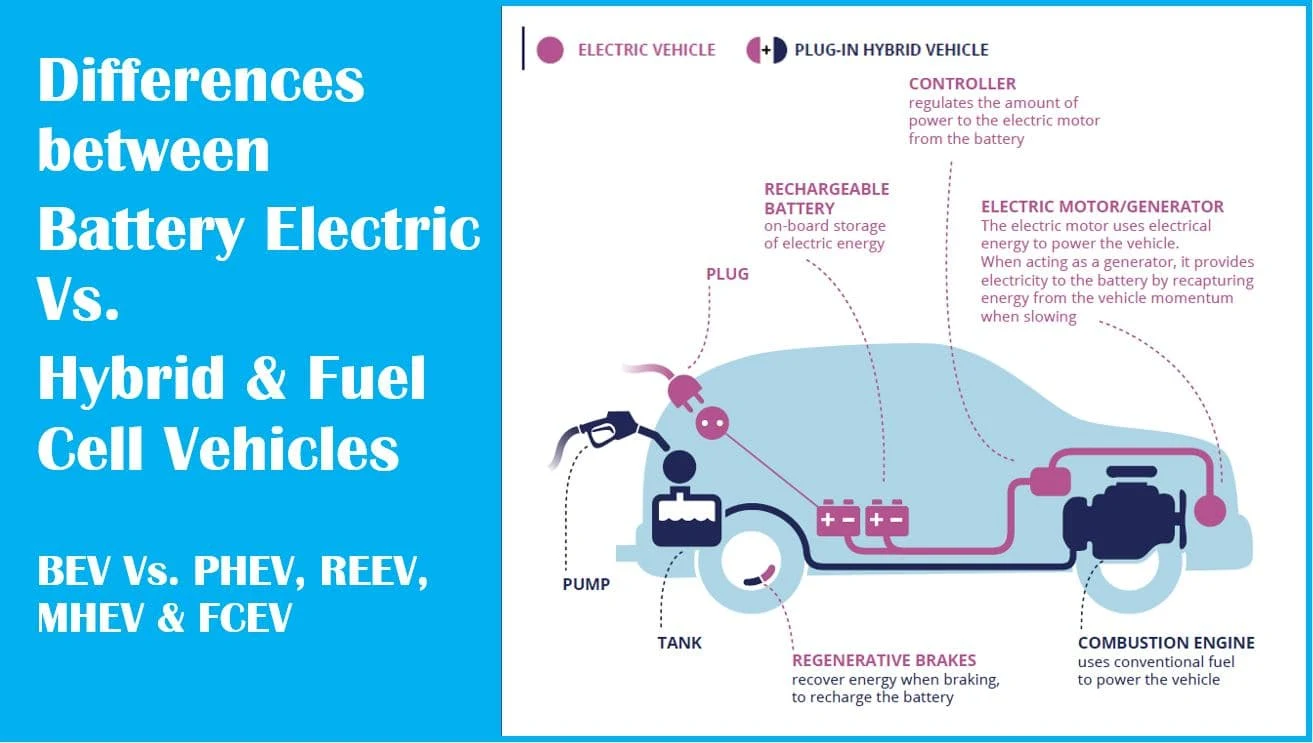EV BASICS 1O3: Differences between Full-Electric Vs. Hybrid & Fuel Cell Vehicles | BEV, PHEV, REEV, MHEV & FCEV
With increasing number of different electric vehicle variants in the market, consumers are often confronted with many abbreviations such as: BEV, HEV, PHEV, FCEV .... Have you ever lost yourself in this labyrinth of shortcuts? This article will help you find your way out!
Electric vehicle (EV) is a widely used term that refers any vehicle that uses electricity for propulsion. In a broad sense, electric vehicles can be divided into Full-Electric or Battery Electric Vehicles (BEV), Hybrid Electric Vehicles (HEV) and Fuel Cell Electric Vehicles (FCEV).1. BEV / PEV :
BEV refers to Battery Electric Vehicle, which runs by an full electric motor powered by a battery pack. Since they solely rely on electricity as their source, they are also known as Pure Electric Vehicles (PEV).Battery of these vehicles must be regularly charged, typically by plugging in the vehicle to a charging point. BEVs have the highest energy efficiency of all vehicles (including conventional ICEs) ; they are able to convert around >80 % of the energy stored in the battery into motion.
💡Example of BEVs: Tesla (all models), Nissan Leaf, Volkswagen e-Golf
2. FCEV :
FCEV refers to Fuel Cell Electric Vehicles. Like a BEV, the FCEVs also have only electric motor, but uses a different method of storing and sourcing electricity. In FCEVs, much of the traction battery is replaced by a hydrogen tank; and a series of fuel cells convert hydrogen into electricity and water vapor, through a chemical reaction.💡Example of FCEVs: Toyota Mirai, Honda Clarity, Hyundai Nexo
3. HEV:
HEV refers to hybrid electric vehicles. HEVs have both an internal combustion engine (ICE) and electric motor. The Hybrid Vehicles (HEVs) can be further classified based on two differentiation criteria.➤According to arrangement of the drive train: Hybrid electric vehicles are separated in to Serial hybrid (or often referred as REEV - range-extended electric vehicle), Parallel hybrid, power-split hybrid or mixed hybrid.
➤According to degree of hybridization: the power component of the electric drive is classified as micro, mild, full and plug-in hybrid (PHEV).
Let’s a take a quick look into the above mentioned different types of hybrid electric vehicles and see what parameters them different from each other.

Hybrid vehicles classification based on arrangement of the drive train:
3.1 Serial Hybrid (Range Extended Electric Vehicle – REEV)
Serial hybrid vehicles have both an internal combustion engine (ICE) and electric motor, but 100% of their propulsion done by the electric motor. The internal combustion engine here operates as just a generator and thus has no mechanical connection to the drive.In urban traffic, and especially in the stop-and-go area, where the combustion engines of conventional cars are less efficient, this hybrid is mostly preferred.
💡An example for serial hybrid / REEV is : BMW i3 with range extender.
3.2 Parallel Hybrid:
In a parallel hybrids, the inter combustion engine and electric motor are connected in parallel. Thus, either the internal combustion engine alone, the electric motor alone or both combined can act on the drive train. Compared to the serial hybrid, it is more efficient at higher speeds, where it can harness the potential of the two-engine combination when needed. An example of this is the Honda Civic Hybrid.💡An example for parallel hybrid vehicle is: Honda Civic Hybrid.
3.3 Power Split Hybrid / Mixed Hybrid:
Cross-power hybrids can switch between the serial and parallel modes to take full advantage of each mode. This means that it can be driven purely by an electric motor, purely by an internal combustion engine, or a combination of both.💡An example for this mixed Hybrid vehicle is : Opel Ampera.
Hybrid vehicles classification according to degree of hybridization
3.4 Micro & Mild Hybrid Vehicle
The micro as well mild hybrids (MHEV) are equipped with an electric motor, but still uses an internal combustion engine to drive the train. The primary role of the electric motor is just to support the combustion engine, for example, when starting or accelerating. These vehicles also equipped with an auxiliary battery with greater current capacity to improve regenerative braking. This in turn further increases fuel efficiency and thus reduces CO2 emissions.💡 These micro & mild hybrids were a big topic of conversation around the world, about 10 years ago; but not anymore!. Examples for these Mild Hybrids are: BMW i8, and Mitsubishi Outlander hybrid.
3.5 Full hybrid
A full hybrid can be driven purely with electric drive if required; something similar to serial hybrid (range extender vehicle). But these are typically limited with a smaller battery capacity.3.6 Plug-in hybrid (PHEV)
From a technical point of view, a plug-in hybrid is essentially a full hybrid with additional technology. The difference between a full hybrid and a plug-in hybrid (PHEV) is that the full hybrid electric vehicle battery is charged solely by regenerative braking or the combustion engine, while the plug-in hybrid's enlarged traction battery is also charged through a power outlet or charging station can be.As a result, these plug-in hybrids can drive ~100 kilometres solely on battery, without igniting the internal combustion engine at all. This becomes a great advantage, especially with in cities and for day-to-day small commutes. This variant also enables the lowest CO2 emissions possible among various hybrid configurations. Thus, often gets you eligibility for environmental incentives and tax benefits.
💡Examples for plug-in hybrids are: Chevy Volt, Hyundai Ioniq PHEV and VW Golf GTE









Post a Comment